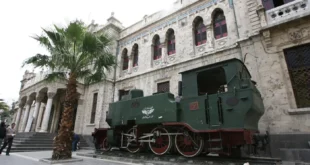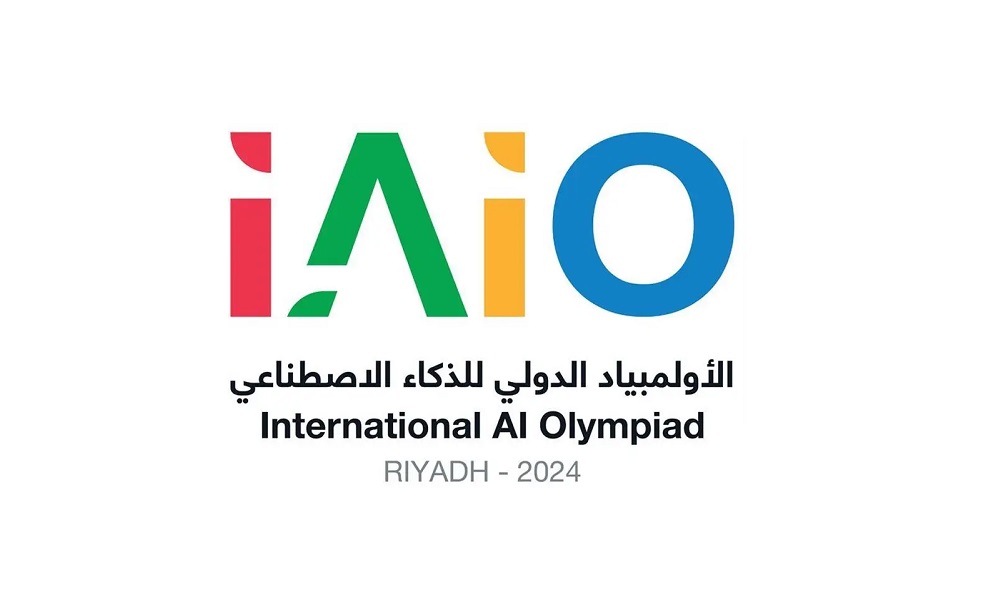After years of restoration, the ninth-century Qarawiyyin library in north-eastern Morocco is finally set to reopen – with strict security and a new underground canal system to protect its most prized manuscripts
The caretaker stares at the wrought iron door and its four ancient locks with a gleam in his eyes. Outside, the Moroccan sun shines down upon the ornate coloured tiles of Khizanat al-Qarawiyyin, located in the old medina of Fez. This, it is widely believed, is the oldest library in the world – and soon it will be open to the general public again.
“It was like healing wounds,” says Aziza Chaouni, a Fez native and the architect tasked with restoring the great library.
The iron door is found along a corridor that once linked the library with the neighbouring Qarawiyyin Mosque – the two centres of learning and cultural life in old Fez. Inside it were kept the most prized tomes in the collection; works of such immense import that each of the four locks had separate keys held with four different individuals, all of whom had to be present for the door to be opened.
The restored library boasts a new sewerage and underground canal system to drain away the moisture that had threatened to destroy many of its prized manuscripts – plus an elaborate lab to treat, preserve and digitise the oldest texts. The collection of advanced machinery includes digital scanners that identify minuscule holes in the ancient paper rolls, and a preservative machine which treats the manuscripts with a liquid that moistens them enough to prevent cracking.
A special room with strict security and temperature and humidity controls houses the most ancient works. The most precious is a ninth-century copy of the Qur’an, written in ornate Kufic script on camel skin.
The must of old books permeates the reading room, and the copies feel fragile and dusty, wearied by years of disuse. Some are wrapped up to prevent them disintegrating in your hands.
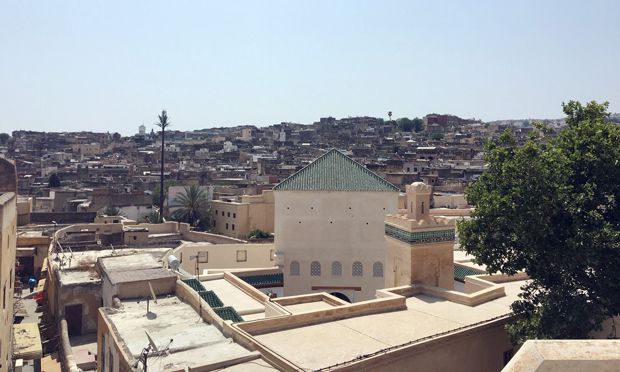
“The people who work here jealously guard the books,” says one of the caretakers. “You can hurt us, but you cannot hurt the books.”
The library’s restoration comes at a time when extremists are rampaging the region’s heritage. Across Syria and Iraq, the militants of the Islamic State have carried out cultural atrocities that include ransacking the great library of Mosul, burning thousands of manuscripts, bulldozing ancient Assyrian cities like Nimrud and Hatra in Iraq, blowing up the Temple of Bel in Palmyra and sacking the oasis city’s museum, in addition to destroying tombs and mausoleums of Shia and Christian saints.
Those troubles seem a world away in Morocco, which managed to remain unscathed by the tumult that has gripped the region and brought down venerable nation states. The king introduced reforms that placated enough of the middle class without devolving too much power to the Islamist-dominated parliament, and peace was largely restored after a series of protests in early 2011.
In 2012, the ministry of culture, which manages the Qarawiyyin library and university, asked Chaouni to assess the library, and she was pleasantly surprised when her architecture firm was awarded the contract, in a field traditionally seen as a man’s province.
The Qarawiyyin library was also founded by a woman. In the ninth century, Fatima al-Fihri, the daughter of a wealthy merchant from Tunisia’s Kairouan, arrived in Fez and began laying the groundwork for a complex that would include the library, the Qarawiyyin Mosque, and Qarawiyyin University, the oldest higher education institution in the world – with alumni including the Jewish philosopher Moses Maimonides, the great Muslim historian Ibn Khaldun, and the Andalusian diplomat Leo Africanus.
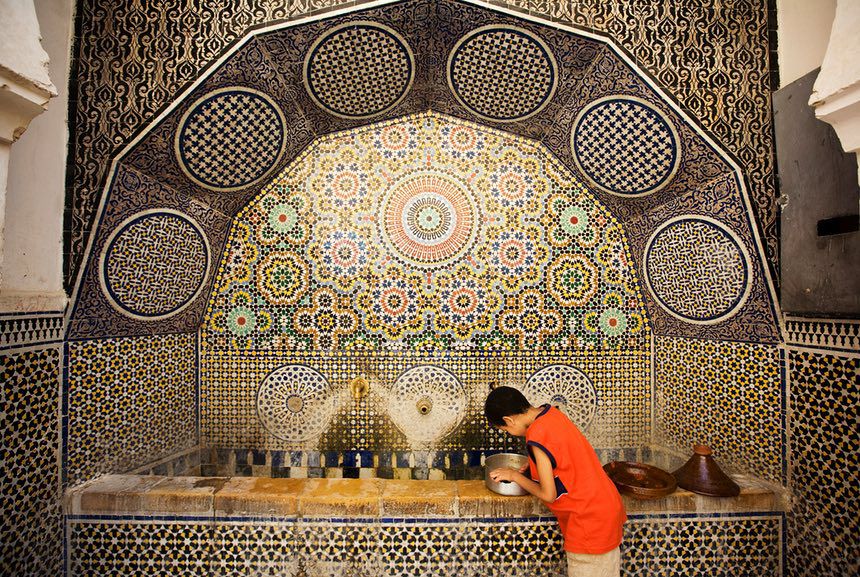
From the library’s roof, the old city of Fez stretches out into the distance; its narrow streets crowded with life. Residents are animated despite fasting in the beating heat of Ramadan, shoppers haggle for leather goods crafted in the ancient tannery, and blacksmiths and copper artisans sweat in the shade of their workshops. Through the winding alleys the odour of treated leather mixes with the call to prayer. It is as though time has stood still.
Craftsmen say it is harder to make a living these days, with the prices of raw materials rising and the lure of cheap, mass-produced wares drawing away customers; but still they toil day after day, far from the lush boulevards of the more modern downtown Fez.
The restoration of the library fits into this pattern – Aziza Chaouni recalls stories of how her great-grandfather travelled on a mule from his ancestral village in Morocco to study at Qarawiyyin University in the 19th century.
“One of his homes was the library,” she says. “It has this magical aura.”
Growing up in Fez, Chaouni would often visit her great-uncle’s workshop at the coppersmiths’ quarter just a stone’s throw away from the library, and would be confronted by its immense closed door at the entrance, and wonder what lay beyond. Once she was in charge of restoring it, she wanted to do more than just fix the broken tiles.
“It has to continue to live,” she says. “I hope it will open soon, and the public will come and enjoy seeing the manuscripts for the first time. But I also hope that the people from Fez will use the space like a second home. The library’s value is not simply to preserve it for tourists, but that it is functioning.”
Engineers worked to determine the structural integrity of the library, restoring some of the woodwork but all the while trying to preserve as much of it as possible. They were helped by the fact that France had undertaken a significant restoration project in the 1940s with the aim of allowing non-Muslims access to the library. They also installed a new chandelier in the reading room, a high-ceiling hall with polished wooden desks and chairs, and intricate reliefs on its columns.
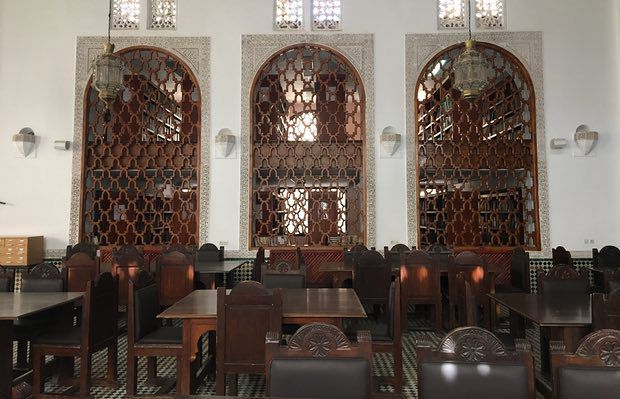
The library is expected to be reopened for visitors later this year after an initial target of summer 2016, and then September, slipped by. No definite date has been set, but the architects remain confident it will happen before 2017. As a sign of the authorities’ investment in the restoration, King Mohammad VI inspected the work in June, and the monarch is expected to inaugurate the reopening.
The renovation is at the forefront of the plan to restore Fez to its status as a spiritual and cultural capital, which it was for centuries, until Rabat became the centre of political life when Morocco was still a French protectorate. Many of the city’s thinkers and intellectuals left Fez, condemning it to a future as a provincial city, but fortunately preventing the gentrification of the old medina, which maintains its earthy quality to this day.
Now renovations are taking place in other quarters of the city. Sufi and music festivals have also injected with fresh blood, as young people rediscover the medina throughout the year. Plans are being made for an exhibition that would showcase the most prized collections in the library.
But for Chaouni, the sustainable architecture philosophy also means the library cannot be a relic of ages past, but a breathing part of the city, much like the old medina is still an inhabited living organism.
It is a philosophy she takes to heart. Chaouni also drafted a plan to restore the river in Fez, which was once known as the river of jewels, but was gradually drenched in waste from the local tannery and sewage from the surrounding residences, and then partially covered with concrete and trash. The river is slowly coming to life now.
“I would like my kids to be able to see this heritage,” she says, recalling how in her childhood she could scarcely see inside the walled-off complex.
“The medina of Fez has the largest pedestrian network, the largest number of historic buildings inside, and I think as a model, as a living city, it’s not just a city for tourists,” she adds. “It is still transforming and adjusting, and as a pedestrian city it’s a great model for sustainability.”
Source: https://www.theguardian.com
Post Disclaimer | Support Us
Support Us
The sailanmuslim.com web site entirely supported by individual donors and well wishers. If you regularly visit this site and wish to show your appreciation, or if you wish to see further development of sailanmuslim.com, please donate us
IMPORTANT : All content hosted on sailanmuslim.com is solely for non-commercial purposes and with the permission of original copyright holders. Any other use of the hosted content, such as for financial gain, requires express approval from the copyright owners.
 Sri lanka Muslims Web Portal Sri Lanka Muslims News Center
Sri lanka Muslims Web Portal Sri Lanka Muslims News Center
 Donate
Donate